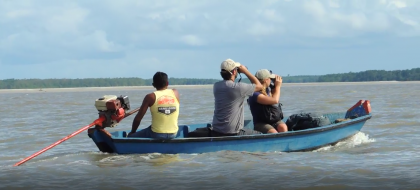
Brazil’s coastline in the northern states of Maranhão and Pará is one the most important places in the world for wintering shorebirds. Over the last two winters, we have done field surveys at numerous sites throughout this region.
The goal of our project is to identify the most important habitat areas for shorebirds. We’re studying the coastline between São Luís and Belém, at the mouth of the Amazon River. The straight-line distance between São Luís and Belém is 400 miles. But due to the coast’s indentations and meandering waterways, the true length might be three times this measurement.
When the project is complete, we will have a far deeper understanding of the ecology and habitat needs of the range of shorebird species using the coast of Brazil. Because we are working closely with Brazilian shorebird biologists as well as Brazilian reserve planners and managers, we can be assured that these new findings will be integrated into Brazil’s conservation programs.
This coordination is more essential than ever. The shorebird populations that winter in the region are declining. We need to ensure that the vast coastal ecosystem spanning Maranhão and Pará where the birds spend eight months a year remains intact while conservationists throughout the flyway work to identify and the address the issues in Brazil and elsewhere that are driving population declines.
When we talk about habitat for shorebirds, there are two key components to consider. The first component is feeding habitat — intertidal mud and sand flats that become exposed when the tide falls. The second component is roosting habitat — beaches and other high ground where birds congregate to roost at high tide while they wait for the feeding habitat to become exposed again.
The coastal landscape of Maranhão and Pará is a big, wild place filled with mangroves, beaches, tidal flats and sparse settlements, but how much of it is prime shorebird habitat?
In the last two years, we have answered this question by documenting habitat conditions and shorebird distribution across the region.
In our effort to cover as much ground as possible, our ten-person crew traveled by convoy and cargo boats to access remote villages and towns where we then hired small boats to help us survey habitat and shorebird distribution.
For food and lodging, we winged it. We slept on beaches, in hammocks under various village shelters, and (occasionally) in nice hotels. Where there were no restaurants, fishermen’s families cooked us meals of beans, rice, fish and farinha.
Although it is impossible see every inch of the coastline, we’ve sampled enough of it to now develop statistical habitat models based on satellite imagery that will encompass the entire region.
Our experiences in the field have already led to some insights.
It’s clear that the landscape is heterogeneous. Every inch of the place is not dense with shorebirds.
Instead, there are hotspots.
When the habitat modelling is completed we will have a clearer view of what makes a hotspot, but a few patterns are already obvious.
First of all, we know that “crab flats” attract high densities of shorebirds.
These flats are lumps of intertidal mud absolutely crawling with fiddler crabs. Whimbrels, willets and scarlet ibis stalk the crabs, while ruddy turnstones squabble over leftover crab parts and laughing gulls wait for a chance to steal crabs from all the other birds.
At the margins of the flats where mud and sand mingle, we often found red knot, short-billed dowitcher and semipalmated sandpipers.
We often saw semipalmated sandpipers feeding in soupy mud, while dowitchers and knots used areas with a thin veneer of sand over mud. The exact habitat preferences of these species are more difficult to discern because we saw them feeding in a variety of settings.
Intertidal feeding hotspots may be particularly important if they are close to high tide roosting sites.
Contrasting with crab flats, intertidal flats composed of pure sand held little interest to the birds. Here shorebirds fed in very low densities. We saw only scattered small groups of semipalmated plover, whimbrel and black-bellied plover.
Some of the shorebirds, such as ruddy turnstones, are habitat generalists. We’ve seen them feeding on rocks, on dead trees covered with marine life and on all manner of tidal flats.
Others seem to be specialists. Willets, for example, are never found far from crab flats.
The project’s next stage will be led by remote sensing experts Rick Lathrop and Dan Merchant of Rutgers University. Their challenge will be to divine the distribution of these hotspots across the landscape.
Our ground-based data on habitat characteristics and shorebird species distribution will make the task possible when linked with satellite imagery.
Once the maps are complete, we will translate and distribute them to Brazilian shorebird scientists and conservation agencies. They’ll use this information to inform shorebird conservation planning and in the managing and establishing of conservation areas.